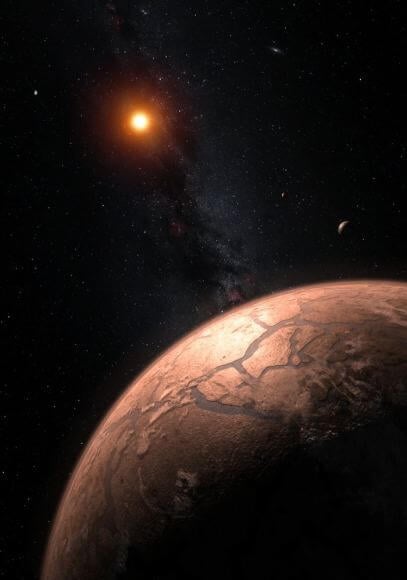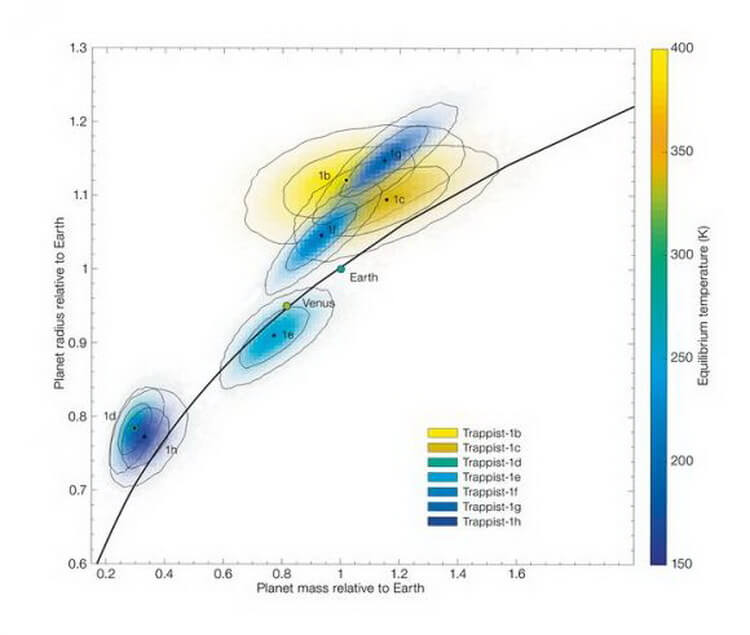
The opening last year of the planetary system TRAPPIST-1 caused a lot of delight. Seven planets orbit the star class red dwarf and are “only” 40 light years from Earth. The opening of this system, astronomers believed that at least some of its planets can be attributed to the earth. The results of a new study TRAPPIST-1 suggests that on some planets of the system water may be even greater than on Earth. In some cases up to 250 times more.
In the new study, the researchers decided to find out the density of the seven planets in the system are TRAPPIST-1. But even if you have in your disposal a very powerful telescope for astronomers but this task proved very difficult. The study involved space telescope “Spitzer” space telescope “Kepler”, and the telescopes of the program SPECULOOS, located in Parnasskii Observatory and belonging to the ESO (European southern Observatory).

The artistic representation of several planets located near ultrakorotkim red dwarf TRAPPIST-1. A new monitoring system and complex analysis of the data has provided scientists information about the density of all seven planets samplemodeling, pointing also to the fact that some of them are very rich in volatile substances, probably water
Data collection from three powerful telescopes have allowed scientists to conduct a fairly complex computer simulation in which were determined the density of the planets. As a result, scientists have found that all the planets in General rocky, and in 5 percent of the mass of some of them can have water. As a comparison, on Earth the figure is of the order of 0.02 percent.
As mentioned above, to determine the density of the planets has proven difficult. At first, scientists had to figure out their weight and size. Recall that the planets in the system TRAPPIST-1 was discovered by the transit method of finding exoplanets. When the planet passes by its star, it partially blocks some flow to the side of the observer of light. The transit method, in addition, gives the opportunity to estimate the size of the planet making the transit.
It is much more difficult to determine their mass, as the planets of different masses can have the same orbit, so to determine something for certain, as a rule, is not possible. However, in the case multiplanetary such as TRAPPIST-1, method found.
With the rotation around the star TRAPPIST-1 more massive planet, compared to more light have a much stronger gravitational effect on the orbits of other planets. This impact also affects transit time. These effects are “very complex and subtle,” says the team of scientists, and to determine the density of each planet took a lot of time to carry out observation and measurement of the transit time, as well as a very complex computer simulation.
“Planet system TRAPPIST-1 is located close enough to each other that each of them acts on its neighboring own gravity. Therefore, when one or the other planet passes in front of stars, its transit time is slightly different. These changes will depend on the mass of the planet, its density and other orbital parameters. Using a computer model we created a simulation of the orbits of the planets as long as the estimated transit time is not consistent with the observed values, and thus we were able to determine their mass,” explains the head of research Simon Grimm.
And what about water?
First, it is necessary to say at once that in this study, the scientists have not identified the presence of water on planets. They identified the presence of volatile substances, one of which may be water. But even so, it is very important for science results. We increase your effectiveness in the search for new exoplanets, so the next step for us will be to determine the possible properties of their atmospheres.
“At one time the goal of exoplanet research was to study the composition of earth-like planets, the question of determination of the size and temperature on their surface. Open system TRAPPIST-1 and the technological capabilities of the European southern Observatory in Chile, and space telescope “Spitzer” made achieving this goal possible – they gave us first hints of what can be done earth-like planets,” says Eric Agol, one of the participants in these studies today.

The image shows a comparison of masses and energies of the seven planets TRAPPIST-1 with the properties of the four inner planets of the Solar system
In this study, the astronomers had determined the following:
- Planet TRAPPIST 1-b and 1c are closest to the star with high probability have a solid core and surrounded by an atmosphere, which can be denser than Earth.
- Planet TRAPPIST-1d is the most lightweight among the planets of the system. Its mass is only 30 percent of the total mass of the Earth. Scientists are not sure whether a planet has a dense atmosphere, ocean or ice surface layer.
- Planet TRAPPIST-1e surprised scientists. This is the only planet whose density is above the earth. The researchers suggest it has a dense iron core. The planet may have an atmosphere, ocean or ice layer. TRAPPIST-1e was for astronomers real mystery, as it is, in their opinion, has a much more solid structure compared to the other planets of the system. It is most similar to Earth. At least in their size, density and the amount of cosmic radiation that it receives from its home star.
- Planet TRAPPIST-1f, g and h may have an icy surface. Even if they have a atmosphere, then it is likely to be heavier elements like carbon dioxide, which can be found in the earth’s atmosphere.
The system study TRAPPIST-1 will continue for a very long time. It is expected that the system will be one of the first objectives of the new space telescope James Webb. Even if it turns out that none of the planets in the system are not suitable for life, their study can tell us a lot about where to look for water, potentially habitable worlds and life in space.
In the planetary system of TRAPPIST-1 can be a lot of water
Nikolai Khizhnyak